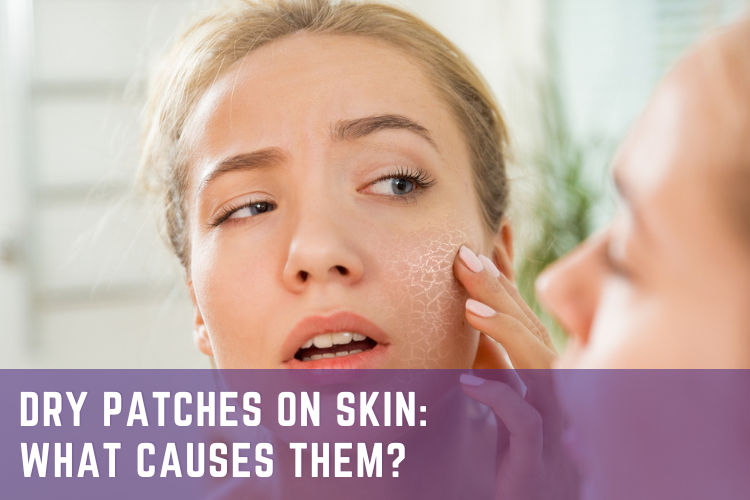
Dry Patches on Skin: What Causes Them?
Dry patches on skin are caused by various factors. Find out what causes them here and the best treatment options for them.
Across the United States, at least 81 million people suffer from dry, itchy, or scaly skin regularly, and in the winter months, dry patches on skin affect even more people.
There are various reasons why someone will have flaky or dry skin. Some have to do with medical reasons, allergies, or environmental factors such as heat, wind, low humidity, and high altitude.
If you suffer from some dry patches of skin, you’ll only know too well how uncomfortable it can be with the temptation to scratch it. This can damage the skin and lead to painful cracks and even scarring.
In this article, we look at what causes dry skin, what you can do to prevent it from happening, as well as treatments. Read on to find out more.
What is Dry Skin?
Skin becomes dry when it doesn't have enough moisture in it to keep it feeling supple and soft. Dry skin can feel rough, and if your skin is beginning to flake, it can look scaly. In severe cases of dry skin, it may be painful or crack and bleed.
The medical name for dry skin is xeroderma. If you have severely dry skin, then it’s referred to as xerosis.
Causes of Dry Patches on Skin
If you have a patch of dry skin, it will mostly fall under one of these categories. These are the most common causes of dry skin.
Contact Dermatitis
This happens when an irritant comes into contact with the surface of your skin that causes an allergic reaction. It can cause your skin to be dry, itchy, and red. It s not uncommon to also have a skin rash.
Contact dermatitis can be caused by cosmetics, medications, detergents, and jewelry that contains nickel.
Eczema
Eczema looks red, dry, bumpy, and forms as itchy patches of skin. You can get it anywhere on your body, in a range of severities.
The most severe cases cause cracking of your skin; this is painful and also leaves your skin prone to infections. Eczema is a fairly common cause of dry skin and can be exacerbated by irritants, allergens, and stress.
Seborrheic Dermatitis
Another cause of dry skin could be seborrheic dermatitis, which can appear on your scalp. Its the result of dandruff in adults, or cradle cap in infants.
You can also get this type of skin complaint on your face, chest, and in the creases of your arms and legs. It’s caused by your body reacting to the normal yeast that grows on your skin.
Psoriasis
This is a long-term inflammatory skin ailment that causes dry patches on the skin. Psoriasis appears as red and thickened skin. It can appear anywhere on your body, although most cases appear on the face.
It’s caused when skin cells are replaced quicker than normal and can be caused by a problem with the immune system or genetics.
Athlete's Foot
Dry skin on the feet, such as a callous, is common. Athlete’s foot can appear as dry skin on your feet; however, it’s a fungus.
It’s the same fungus that causes ringworm inside your body. It causes the soles of your feet to be dry and flaky.
Common Reasons for Dry Skin
Anyone can suffer from dry skin; however, some things can make you more susceptible to it. These are the common reasons why someone may suffer from dry patches on their skin.
- Live in a dry or cold climate
- Frequently work outside
- Wash your hands frequently
- Come in contact with detergents or chemicals
- Have another health condition such as allergies
- If you are 65 years or older
The Symptoms of Dry Skin
There are several symptoms of dry skin; often you’ll have a combination of a few signs.
- Cracked
- Rough
- Tight
- Flaking
- Scaling
- Itchy
- Change in color
Treatment Options for a Dry Skin Patch
Different treatments can help dry patches of skin, depending on the types and causes.
For example, if the dry skin is caused by a fungal infection, then you’ll need an antifungal medication to treat your symptoms. These are the types of dry skin treatments available.
Lotion and Moisturizers
These help to lock in moisture and are most effective when they are applied after a shower or washing your face. These work well for minor dry skin problems and are widely available.
Exfoliating
Removing the dead skin cells from the surface of your skin will make it appear less flaky and help to prevent the build-up from forming dry patches. There are different types of exfoliating treatments available, either through chemicals like salicylic acid or physical scrubs.
This method shouldn’t be used with broken skin.
Topical Creams or Ointments
These are specialist creams and ointments that can contain fungal treatments and antihistamines. They can help clear up more severe dry skin problems that are causing dry skin. Specialist creams are available to help treat eczema, psoriasis, and athlete’s foot.
Some of these are available in stores.
Prescription Medications
If you have a serious skin condition, over-the-counter treatments may not be suitable. You may be prescribed a medicated cream or tablets to help clear up your skin condition.
Discover More Great Skin Care Products
Whatever your skin problem is, Theraderm can help. If you’re looking to treat dry patches on skin, we offer a range of skincare system products for a range of skin types.
Theraderm has been developing skin health products over the past 40 years based on advances in cellular biology to create products that address a wide variety of skin conditions. Whether you’re looking to treat acne, deep wrinkles, or uneven skin tone, we deliver world-class solutions.
Visit our online shop today, to see our extensive range of moisturizing products and find out how we can help.



